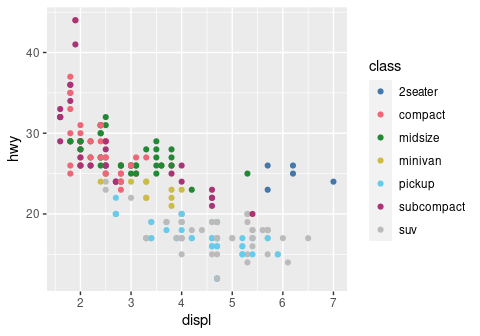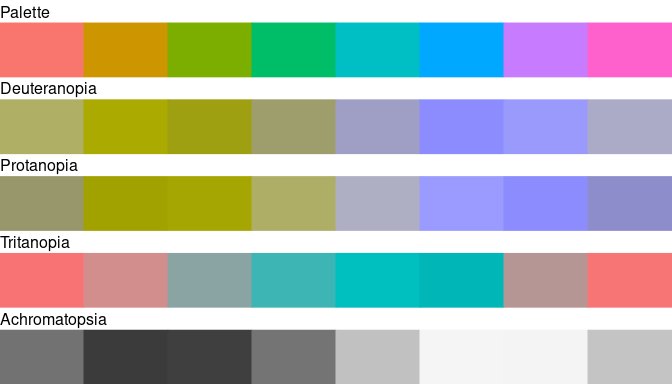

Color blindness affects a large number of individuals. When communicating scientific results colour palettes must therefore be carefully chosen to be accessible to all readers.
This R package provides an implementation of Okabe and Ito (2008), Tol (2021) and Crameri (2018) colour schemes. These schemes are ready for each type of data (qualitative, diverging or sequential), with colours that are distinct for all people, including colour-blind readers. This package also provides tools to simulate colour-blindness and to test how well the colours of any palette are identifiable. To simulate colour-blindness in production-ready R figures you may also be interested in the colorblindr package.
Tol (2021) and Crameri (2018) offer carefully chosen schemes, ready for each type of data, with colours that are:
See vignette("tol") and vignette("crameri")
for a more complete overview.
For specific uses, several scientific thematic schemes (geologic timescale, land cover, FAO soils, etc.) are implemented, but these colour schemes may not be colour-blind safe.
All these colour schemes are implemented for use with base R or ggplot2 and ggraph.
You can install the released version of khroma from CRAN:
install.packages("khroma")And the development version from GitHub with:
# install.packages("remotes")
remotes::install_github("tesselle/khroma")## Load packages
library(khroma)
## Install extra packages (if needed)
# install.packages(c("ggplot2", "spacesXYZ"))## Get a table of available palettes
info()
#> palette type max missing
#> 1 broc diverging 256 <NA>
#> 2 cork diverging 256 <NA>
#> 3 vik diverging 256 <NA>
#> 4 lisbon diverging 256 <NA>
#> 5 tofino diverging 256 <NA>
#> 6 berlin diverging 256 <NA>
#> 7 roma diverging 256 <NA>
#> 8 bam diverging 256 <NA>
#> 9 vanimo diverging 256 <NA>
#> 10 oleron diverging 256 <NA>
#> 11 bukavu diverging 256 <NA>
#> 12 fes diverging 256 <NA>
#> 13 devon sequential 256 <NA>
#> 14 lajolla sequential 256 <NA>
#> 15 bamako sequential 256 <NA>
#> 16 davos sequential 256 <NA>
#> 17 bilbao sequential 256 <NA>
#> 18 nuuk sequential 256 <NA>
#> 19 oslo sequential 256 <NA>
#> 20 grayC sequential 256 <NA>
#> 21 hawaii sequential 256 <NA>
#> 22 lapaz sequential 256 <NA>
#> 23 tokyo sequential 256 <NA>
#> 24 buda sequential 256 <NA>
#> 25 acton sequential 256 <NA>
#> 26 turku sequential 256 <NA>
#> 27 imola sequential 256 <NA>
#> 28 batlow sequential 256 <NA>
#> 29 batlowW sequential 256 <NA>
#> 30 batlowK sequential 256 <NA>
#> 31 brocO sequential 256 <NA>
#> 32 corkO sequential 256 <NA>
#> 33 vikO sequential 256 <NA>
#> 34 romaO sequential 256 <NA>
#> 35 bamO sequential 256 <NA>
#> 36 bright qualitative 7 <NA>
#> 37 highcontrast qualitative 3 <NA>
#> 38 vibrant qualitative 7 <NA>
#> 39 muted qualitative 9 #DDDDDD
#> 40 mediumcontrast qualitative 6 <NA>
#> 41 pale qualitative 6 <NA>
#> 42 dark qualitative 6 <NA>
#> 43 light qualitative 9 <NA>
#> 44 sunset diverging 11 #FFFFFF
#> 45 BuRd diverging 9 #FFEE99
#> 46 PRGn diverging 9 #FFEE99
#> 47 YlOrBr sequential 9 #888888
#> 48 iridescent sequential 23 #999999
#> 49 discreterainbow sequential 23 #777777
#> 50 smoothrainbow sequential 34 #666666
#> 51 okabeito qualitative 8 <NA>
#> 52 stratigraphy qualitative 175 <NA>
#> 53 soil qualitative 24 <NA>
#> 54 land qualitative 14 <NA>colour() returns a palette function that when called
with a single integer argument returns a vector of colours.
If crayon is
installed on your machine and if the crayon.enabled option
is set to TRUE with options(), colours will be
nicely printed in the console. You can disable this feature by setting
the crayon.enabled option to FALSE.
## Paul Tol's bright colour scheme
bright <- colour("bright")
bright(7)
#> blue red green yellow cyan purple grey
#> "#4477AA" "#EE6677" "#228833" "#CCBB44" "#66CCEE" "#AA3377" "#BBBBBB"
#> attr(,"missing")
#> [1] NA## Show the colour palette
plot_scheme(bright(7), colours = TRUE)
## Use with ggplot2
data(mpg, package = "ggplot2")
ggplot2::ggplot(data = mpg) +
ggplot2::aes(x = displ, y = hwy, colour = class) +
ggplot2::geom_point() +
scale_colour_bright()
## Okabe & Ito's colour scheme
okabe <- colour("okabe ito")
set.seed(12345)
plot_map(okabe(8))
## BuRd sequential colour scheme
BuRd <- colour("BuRd")
plot_tiles(BuRd(128), n = 256)
DeltaE <- compare(okabe(8))
round(DeltaE, 2)
#> black orange sky blue bluish green yellow blue vermilion
#> orange 64.74
#> sky blue 60.95 53.61
#> bluish green 50.51 42.87 34.69
#> yellow 88.42 21.72 57.53 38.04
#> blue 39.23 55.35 22.31 38.40 70.37
#> vermilion 49.36 22.24 52.27 54.36 43.71 49.62
#> reddish purple 53.11 49.01 45.51 63.45 62.54 41.11 37.02plot_scheme_colourblind(okabe(8))
## ggplot2 default colour scheme
## (equally spaced hues around the colour wheel)
x <- scales::hue_pal()(8)
plot_scheme_colourblind(x)
Please note that the khroma project is released with a Contributor Code of Conduct. By contributing to this project, you agree to abide by its terms.